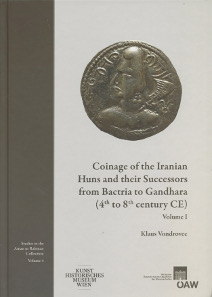
PREV ARTICLE
NEXT ARTICLE
FULL ISSUE
PREV FULL ISSUE
BOOK REVIEW: THE COINAGE OF THE IRANIAN HUNS
Ursula Kampmann published this book review in the December 3, 2015 issie of CoinsWeekly. Here's a lengthy excerpt, but be sure
to read the complete version online. -Editor
When, in 1967, Robert Göbl published his “Dokumente zur Geschichte der iranischen Hunnen in Baktrien und Indien” (“Documents on the history of the Iranian huns in Bactria and India”), he not only introduced the term ‘Iranian huns’ to the academic world, but also focused on an area and a historic period which researcher had hitherto treated like an orphan. His research was based on numismatics, which takes account of the fact that the past of those peoples that once settled in Afghanistan and neighboring India, in parts of Iran, Turkmenistan and Pakistan, could only be reconstructed by accessing numismatic material because only a few other sources have come down to us. With all those shocking news we keep hearing since October 2011, the average Western European at least roughly knows how to pinpoint Afghanistan on the map. But he hardly knows anything about the history of the one so rich region, particularly when this history refers to events that occurred prior to the Russian occupation. The comparatively low scholarly interest, at least until the turn of the centuries, may also have contributed to this. Then, in 2001, an international research project was established which focused on the history of the Western Himalayas. Pursuing an interdisciplinary approach, it promoted archaeology, history, history of art, epigraphy, and linguistics. Of course, numismatics added to this. Consequently, Klaus Vondrovec went along these lines when he revised the old subject matter of Robert Göbl, as part of CHWH (= Cultural History of the Western Himalaya) on a material basis which no longer – as in 1967 – comprised 1,200 coins but nearly 6,500 specimens, stemming from coin finds made in Afghanistan and from auction sale catalogs of Western coin houses. Above all, the special collection of Aman ur Rahman constituted the material basis for Klaus Vondrovec. Or, to be more specific, one of the many special collections of Aman ur Rahman of which some have already inspired research in the past. To ensure that his catalog achieves universality, as intended, the author has integrated further material from a number of renowned coin collections, such as Berlin, London, New York, Oxford, Paris, and Vienna, as well as a few special collections, such as Bern, and a range of private collections, like the Righetto Collection, for example. The material is cataloged in 10 individual chapters.
Every chapter begins with a detailed comment. Broadly speaking, the coin imagery is carefully analyzed first, followed by a historical overview which helps to put the coins in the overall context. The catalog proper comes next, which, paying homage to Robert Göbl as the ‘founding father’ of this discipline, adopts the Göbl numbering. This, however, impairs the work’s clarity. Certainly, many catalog authors would have wished for a bold new start with new numbers (as well as an index contrasting the established Göbl types with the new Vondrovec numbers). At any rate, the catalog is lavishly illustrated, with special care devoted to the photographs. It is sometimes hard, particularly with the bronze coins, to recognize every detail of coin by a look at the photographs alone. Where necessary, the author thus provides clarifying drawings, which are all highly welcome! To be frank, the reader would appreciate if more of these drawings were given. By a look at the “Typological overview” (thanks to the author for this wonderful tool!) it becomes apparent how important these drawings actually are. Although Klaus Vondrovec chose the best possible image available of the best preserved specimen of every single series, any non-initiated reader will spend some time on searching. To read the complete article, see:
Wayne Homren, Editor The Numismatic Bibliomania Society is a non-profit organization promoting numismatic literature. See our web site at coinbooks.org. To submit items for publication in The E-Sylum, write to the Editor at this address: whomren@gmail.com To subscribe go to: https://my.binhost.com/lists/listinfo/esylum All Rights Reserved. NBS Home Page Contact the NBS webmaster 
|
 Klaus Vondrovec, Coinage of the
Iranian Huns and their Successors from Bactria to Gandhara (4th to 8th century CE). Studies in the Aman ur Rahman Collection Volume 4.
Vienna, Austrian Academy of Sciences, 2014. 2 vols., 960 pages, color illustrations throughout. Hardcover. 21.5 x 30.2 cm.
978-3-7001-7695-4. 179 euros.
Klaus Vondrovec, Coinage of the
Iranian Huns and their Successors from Bactria to Gandhara (4th to 8th century CE). Studies in the Aman ur Rahman Collection Volume 4.
Vienna, Austrian Academy of Sciences, 2014. 2 vols., 960 pages, color illustrations throughout. Hardcover. 21.5 x 30.2 cm.
978-3-7001-7695-4. 179 euros.